I can’t quite remember the first time I heard about the Pittsburgh steps, but I’m 80% sure that it happened during an afternoon at the Boston Public Library in 2018, when I was doing research for my first hiking guidebook. As I pulled tattered paperbacks off the shelf, leafing through them in a somewhat urgent manner (I had to document 76 New England hikes in less than six months), I noticed an especially weathered spine whose title caught my name. Pittsburgh Steps: The Story of the City’s Public Stairways. Why was this book by Bob Regan in the hiking section, flanked by books about mountains and forests? And why were Pittsburgh’s staircases so noteworthy?
Well, for a start, there are a lot of them.
The City of Pittsburgh is home to more than 800 public stairways that offer direct passage from the city’s urban core into the massive, punishingly steep hills that surround the city. Many of these staircases run directly alongside sloped streets, where one would normally find a sidewalk. But plenty of Pittsburgh’s steps are standalone attractions, burrowing uphill through trees, vines, and dense residential neighborhoods. The original purpose of these stairways was making it slightly easier for workers to commute back home, after a long shift at the steel mills. I don’t know about you, but after toiling all day at a mill, I would not be particularly happy about the prospect of climbing a massive staircase or four, just to return home. (Those workers must have been built like brick shithouses.) But after the 1980s, when most of the mills had shuttered, Pittsburghers continued using those stairs for pure recreation.
Each fall, local stairway enthusiasts organize StepTrek, a Spartacus-sized community hike up and down a Greatest Hits compilation of those steps. (The route is different each year.) When I read about this back in 2018, it made me chuckle, and I moved on to planning autumnal hikes in northern Maine and other traditional hiking destinations. But not long after the pandemic began and I started discovering the pleasures of urban hiking, the mythic Pittsburgh stairways started appearing in my dreams. Many of us count sheep or our breaths: I counted steps, imagining a long, grueling climb from high rises to highland forests. I had to go there. I had to experience these stairs firsthand. And after several failed attempts to travel to Pittsburgh, which is not the easiest city to reach by train or bus (flying there from Boston seemed too decadent), my ship finally came in. I hitched a ride with hiking accomplice and dear friend Katie Metzger, who was driving from Western Mass. to Ohio to visit friends and family. We traded driving duty, and after eight hours of winding through mountains, she left me in Pittsburgh with 48 hours to hike stairs.
And let me tell you: I was not remotely prepared for the physical and sensorial experience that awaited me in Pennsylvania’s roller coaster metropolis.
The first challenge you run into with Pittsburgh stairways is simply deciding which ones you’re going to combine into a hiking route. Bob Regan’s book is a good start for this—it offers several suggested walking routes that showcase especially beautiful stairs. But for a full-on city hike of a few miles or more, your best bet for finding out where the stairs are located and how close or far they are from each other might be this FKT map from a guy named Brenner Burkholder. FKT is an acronym for “fastest known time” and FKT maps are usually created by runners. They head out on a chosen route, with a GPS app, and their activity track becomes a map that people like you or myself can use. Burkholder, if we are to take his map at face value, ran a 31.7-mile loop around Pittsburgh, through the hills, visiting as many stairways as possible: ascending hills, descending them, and then ascending them again. His route is described as “a magnificent, sadistic 50km tour of Pittsburgh, PA’s most unique infrastructural feature.” And after studying this map closely, I came up with a plan.
I would hike 7.5 miles from my Airbnb in Pittsburgh’s East Oakland community (near Carnegie Mellon) to the city overlook at Grandview Avenue, in the South Side Slopes. This is the most plentiful section of the city if you’re looking to explore stairs. The elevation gain for this route would be comparable to climbing a 4,000 footer in the White Mountains. And rather perfectly, the hill on which the Grandview overlook is located just so happens to be called “Mount Washington.”
Also: Did I mention that it was the Fourth of July weekend?
I set off at 8am, fueled by coffee and a butter crunch doughnut. Before hitting the hills, I had to descend to the Monongahela River and cross it via the Hot Metal Bridge. And as I approached the waterway on Frazier Street, I found my first staircase much sooner than expected. It took me down through a dense grove of trees (during the summer, Pittsburgh feels totally overwhelmed by vegetation.) The stairway had a sturdy frame, with thick concrete slabs installed within that frame: sort of like bed slats. And some of those slabs shifted as I descended the old stairs, which was surprising and spooky. This points to something about the Pittsburgh stairs that can be both intriguing and unnerving. With much of its tax base having left, the city struggles to maintain its steps. Some fell into disrepair. And the list is growing.
The preservation of the staircase has been substantially reliant upon the passion of Pittsburgh residents who monitor the stairs, highlight them for the public, and lobby for their maintenance. One such activist is Laura Zurowski, who runs the Mis.Steps website and Instagram page, and leads guided tours along the stairs. And after crossing the Hot Metal Bridge (the weather, I should add, was overcast and humid as fuck) I started wondering if perhaps I should have tried to join one of Zurowski’s tours, which presumably ease you into the rigors of stair climbing. Because at the end of South 30th Street, I found myself staring upward at a dizzyingly steep set of stairs that looked at least 1,000 feet tall. They disappeared into the trees and homes built on the hill. My glutes jiggled and I started preemptively sweating at the thought of climbing not just these steps, but many, many others that I couldn’t see just yet.
This was what I came here for.
There are three ways in which hiking the Pittsburgh steps closely resembles the experience of climbing an actual mountain. First, the relentlessly steep city terrain makes you sweat, quickly and prodigiously, to the point where your shirt is soaked and you can start feeling your nipples chafing against the damp fabric. (Too much information?) Then there’s the way that your climbing environment transforms with each flight of stairs. Just like scaling Mount Moosilauke involves passing from deciduous woods to high altitude boreal forest, a climb up any series of Pittsburgh steps can take you from clusters of densely-packed hillside houses to prehistoric looking urban forests that have literally ensnared the stairs.
And finally, there’s the summit. When you crest a hilltop in Pittsburgh, you reach an exposed zone where the breeze rapidly cools you down. You might get a view of the city below, but even if you don’t, the sensation that you’ve climbed really high is palpable. And then, you start looking for a place to take a well-earned breather.
After my first quad-busting round of steps, I found my rest stop at Hilltop Coffee, an irresistible little cafe on Arlington Street that opened during the first year of the pandemic, in an elevated neighborhood where there aren’t many brick-and-mortar businesses. Co-owner Daniel Gladis was slinging cold brews behind the counter and filled me in on the history of not just the joint, but the preservation of Pittsburgh staircases as well. (Gladis also works as Chief of Staff for Pennsylvania state representative Jessica Benham.) When I asked him if stair climbers often visit the coffee shop, he replied affirmatively and added that his wife is one of the organizers of StepTrek. “You should come back in October,” he said. I nodded, and committed.
In order to squeeze as many steps into my hike as possible, I decided to descend several sets from the hilltop, losing most of the elevation I had gained. This would be the pattern for the rest of my stairway hike—up and down, through various enclaves in the south side hills. And for the most part, I had the steps to myself. Maybe it was too cloudy and muggy for the steps to draw much of a crowd. Or perhaps people were elsewhere climbing actual mountains for the Fourth of July weekend. On one long, particularly bushy staircase through the open green space of South Side Park, I encountered a lone jogger who didn’t appear to be on the verge of death just yet. Things got much quieter as I climbed Welsh Road—a rare, angular street with zero stairs. The sudden strain of climbing uphill without the benefit of stairs was torture for my calves, and it made me appreciate the mercy of an incremental staircase.
As blue-ish thunderheads congregated above the city, I finally reached reprieve from the steps: Emerald View Park. Here I would follow a wooded trail to a city overlook on Bailey Avenue, and from there, I would descend into a hillside cleft on a steeper switchback trail. This would take me to the final staircase of the hike: a long, masochistic climb to Grandview Avenue, where the ultimate Pittsburgh vista (and lunch) would be waiting. Everything went according to plan, at first. The skies gave way to torrential rain just as I re-entered the woods and began cruising down the dirt switchback path to the final stairs. It felt good to be cleansed like this. But after crossing a street to what should have been the gateway to the final staircase, I found myself at a narrow spur road that was overgrown and blocked by a concrete barrier.
Against my better judgment, I hopped over the concrete barrier and started frantically bushwhacking through walls of leaves and weeds. By this point, I was stair-drunk and so determined to scale that last set that I didn’t stop and think about why the entrance to these steps had become so impassable. And pretty soon, the answer revealed itself. A sudden, soggy thunk of concrete beneath my feet caused me to glance down and I realized that I was on the stairs! They were broken, after decades of wear and neglect, and almost completely hidden from view by soil and vegetation. There was no going forward safely. I would have to backtrack up the switchback path and find an alternative route to the Mount Washington overlook. Wet leaves smacking against my face and body—none of which proved to be poison ivy, thankfully—I violently retreated.
(Side note: If a stairway that appears on a map has been completely overgrown, just turn around and don’t try to bushwhack to it.)
By the time I walked into Coughlin’s Law, a rowdy open-air brewpub near the overlook, I was sopping wet and smeared with dirt and forest floor detritus. The host greeted me with friendly words and a more honest look that said, “What the hell happened to you?” Nonetheless, I was seated at an outdoor high-top quickly and soon began recovering with a West Coast IPA. The house burger was topped with pork belly and purple cabbage, and bathed in hickory smoke. (They serve it in a glass container with all the smoke trapped inside, permeating the entire burger!) And by the time I finally stumbled down the street to the city overlook, I was sated in every sense of the word.
To reach the city center again, where I could catch a bus back to my lodging, I took an ethereal ride down from Mount Washington on one of the city’s municipal funiculars, which are known as the Inclines. At one point, there were nearly two dozen of these things running throughout the city hills. Today, there are only two: the Monongahela Incline (which I rode for the bargain price of $2.50) and the Duquesne Incline. And I couldn’t help but think about the Mount Washington Cog Railway in New Hampshire as the little railcar slowly descended the track, toward the river and the high rises. What an incredible city. My only regret was that I had to head back to Boston in less than 36 hours, and that I couldn’t possibly fit my local adventures into one newsletter.
This is my way of saying that unlike normal Mind The Moss newsletters, which have definitive endings, this one will conclude on a more ambiguous, open-ended note. Because Pittsburgh, the city of stairs, is an urban hiking wonderland that I’m fully planning to revisit later this year. Next time, I aim to dig even deeper and meet the community of stair hikers who are involved with the tough work of preserving the stairs. I aspire to join the procession of climbers on StepTrek, wherever this year’s route leads. And I hope to encourage some of you to go to Pittsburgh soon. Just be sure you’re doing your squats and calf raises. I’m already training for my next visit.
”Baby Steps” (my DIY stair hike route)
Hike distance: 7.5 miles point-to-point
Elevation gain: 1,939 feet
CLICK HERE for a trail map


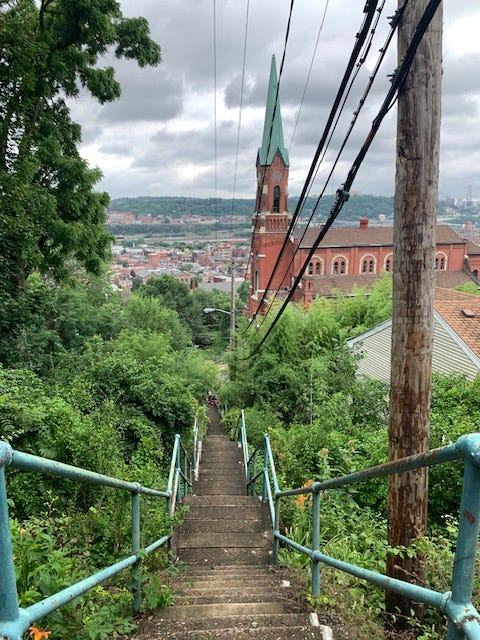
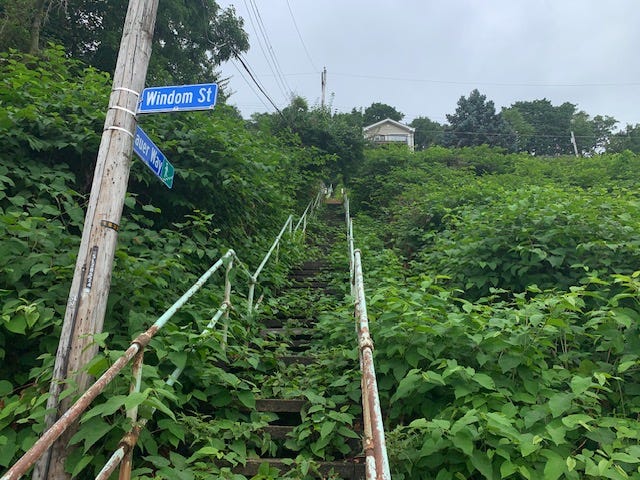


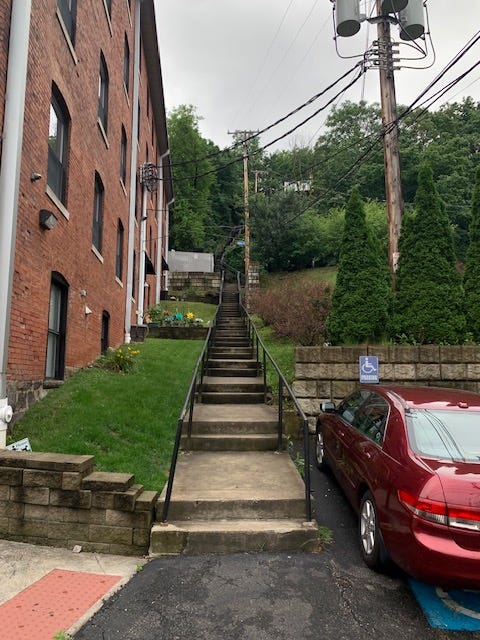


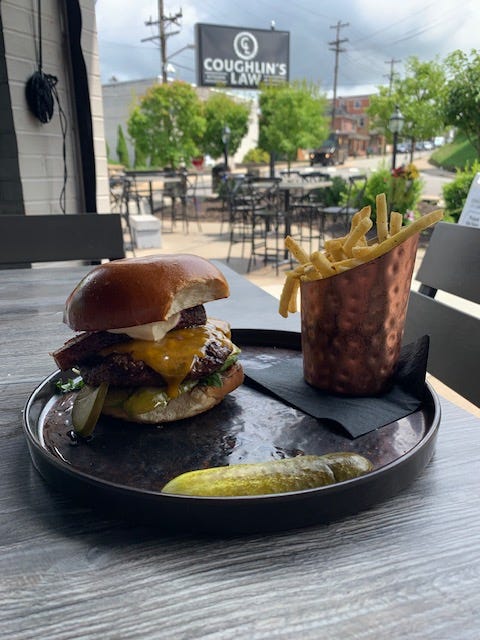

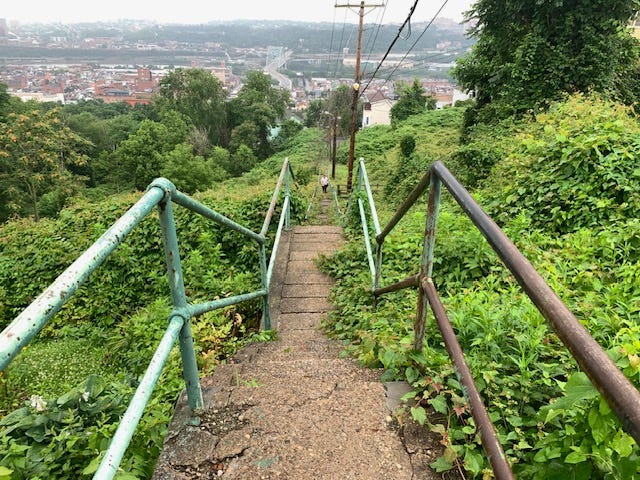
I visited Pittsburgh in my youth (2003?) as part of college tours (and because my cousin had just married into an old Pittsburgh family) and my parents and I loved it. Choosing not to go to college there is probably the major life decision I revisit the most. See if you can get your hands on some old Rick Sebak documentaries as part of your research!